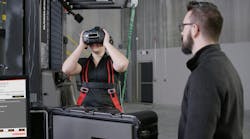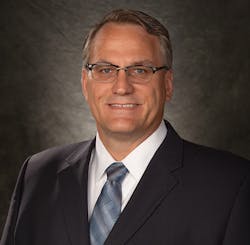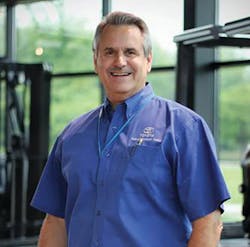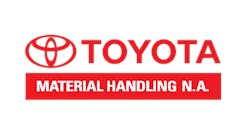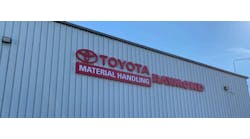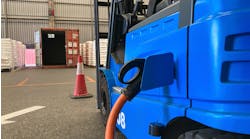One of the biggest challenges for manufacturing and warehousing companies is finding and retaining talent, and this disturbing statistic certainly is a factor: In OSHA’s ranking of the top 10 safety violations in the workplace, forklift operations came in seventh, as OSHA reported 2,093 violations involving forklifts in 2019. And according to the Bureau of Labor Statistics, forklifts were the cause of 74 fatalities and 9,050 nonfatal workplace injuries or illnesses with days away from work in 2017. So in the wrong hands (particularly the untrained or undertrained), these vehicles are quite deadly indeed.
Seven years ago, Material Handling & Logistics and its sister publication EHS Today helped to launch National Forklift Safety Day, an annual event that focuses on the safe use of forklifts and the importance of operator training to foster a safety culture within manufacturing and distribution environments. Although this year’s event ended up going virtual (due to the COVID-19 pandemic), we asked safety experts at several of the major forklift manufacturers to participate in a discussion of current efforts being made to improve overall warehouse safety, and what steps safety professionals should take to ensure that forklift operators and pedestrians alike go home safely every night.
Participating in the forklift safety roundtable (in alphabetical order) are:
• Don Buckman, EHS manager, Americas Division, Yale Materials Handling Corp.
• Ron Grisez, director of product safety, Crown Equipment.
• Jack Kaumo, director of iWAREHOUSE technology solutions, The Raymond Corporation.
• Tom Lego, brand ambassador, Toyota Material Handling.
MH&L: Has forklift safety gotten better since National Forklift Safety Day was launched seven years ago?
DON BUCKMAN: As a past chairman of the Industrial Truck Association’s National Forklift Safety Day, our main message was certainly reinforcing and sustaining the importance of forklift safety through effective operator and pedestrian training. National Forklift Safety Day’s goal continues to be the education of customers, the public and government officials about the safe use of forklifts and the importance of operator and pedestrian safety. Although ITA, along with its members and OSHA, highlight the importance of industrial truck safety on National Forklift Safety Day, “forklift safety is for life,” and this focus has to be a sustainable practice the other 364 days of the year as well.
On a related note, it’s important to understand that safety isn’t an outcome, it’s a culture. Safety is everyone’s job and must extend across operations and the supply chain. It must be driven from the floor as it is driven by the line management and leadership.
RON GRISEZ: Nearly everyone in the industry recognizes and appreciates the important role the ITA and National Forklift Safety Day play in keeping safety top of mind and serving as a reminder that the responsibility for forklift safety extends beyond the operator to supervisors, trainers and pedestrians.
The day gives us an opportunity to remind everyone that safety is not something that deserves focus only during pre-shift inspections or even during safety training itself. It is something that must be top of mind every day, on the job and off. The day helps everyone remember that every single person is a contributor to safety, and it starts with the right mindset that produces safe behaviors.
JACK KAUMO: Spreading awareness of proper operation and training are the key to more efficient operations. Technological advances such as virtual reality simulators and enhanced telematics capabilities allow for operations to access actionable data and improve visibility into operations. Telematics solutions can help material handling operations uncover hidden areas of improvement, Telematics platforms can provide real-time fleet data on what workers are doing, their productivity and other optimization opportunities.
Facility optimization and labor assist technologies also allow operations to connect and communicate directly with their fleet, assets and workforce, resulting in streamlined processes to identify areas for potential improvement. At Raymond, these advanced technologies layer onto our traditional truck offerings, providing operating efficiencies and tools to assist operator productivity and security.
TOM LEGO: Since mandatory operator training was implemented, the industry has seen an overall positive trend in forklift safety. At Toyota Material Handling, we work to manufacture the safest forklifts through the development and implementation of innovative technology. However, technology is not and should never be considered a substitute for proper safety training. We must approach safety from a holistic approach and integrate all facets of safety, including our awareness of facility layouts, routes, environmental conditions, etc.
What are the main reasons that so many accidents happen in a warehouse and on a loading dock? What are the most typical types of accidents?
GRISEZ: That’s a bit like asking why so many car accidents happen at intersections. There are a variety of factors and reasons, with each accident offering something unique. The more important question to ask is how can we make intersections safer, or in this case, warehouses.
It’s important to remember that warehouses and docks are dynamic environments with a lot of activity. Also, while some forklifts may appear smaller than an automobile, they are typically many times heavier, especially when they are carrying a load. This is why forklift safety must never be casual or considered an afterthought.
If you want to build and maintain a strong safety culture that reduces accidents, you must take a holistic approach that considers each aspect of safety while emphasizing the role of the individual. Vital components of a holistic program include:
Training that extends beyond forklift operators.
Equipment design that takes an operator-centric approach.
Connectivity that provides more visibility and awareness.
Improvements that are informed by data analytics.
Compliance management that controls access and automates processes.
That being said, a number of our customers begin their safety improvement journey by looking to reduce forklift impacts. Fleet and operator management systems enable managers to collect a wealth of data that helps create an accurate picture of how the vehicle and operator are performing. Which operators are exhibiting incorrect behavior? Which areas of the facility or shifts see the most impacts? Facility leadership can then use this data to make adjustments in training, maintenance and facility layout. They can also set thresholds to quickly be alerted when an impact occurs so they can investigate.
LEGO: People may think that accidents occur when equipment malfunctions. This is actually quite rare. Warehouses and distribution centers are dynamic places and have processes that involves drivers, operators and the environment. The starting point for everyone is to have good, reliable equipment that is being properly maintained and in dependable condition through proper routine maintenance and daily inspections. Toyota, through our dealers, helps make sure these types of scenarios are safer by assisting customers with choosing the right equipment for the right job. Other safety considerations might include:
● Is the operator properly trained and using the forklift for its intended use?
● Does the operator have a daily inspection checklist for the forklift?
● Are there improvements in warehouse layout, traffic flow, markings, or separations that should be made?
● Are there any blind spots? Does lighting need to be improved? Are there surfaces that need additional traction?
● Are there other accessories which might be considered that could help support operators and those interacting with the equipment?
● Are there adequate procedures in place for good clear communications between workers or pedestrians in the area and the forklift operators?
BUCKMAN: Like many supply chain challenges, labor is a good place to start. Warehouses have extremely high turnover—46.1% in 2019. And with such high turnover, you have a lot of people coming into new roles, without a lot of time and experience in that position, much less in that specific operating environment. In some cases, operators may have zero experience.
In addition to a lack of experience and training, some other causes of forklift accidents include:
Speeding: OSHA advises drivers to stay at or below 5 miles per hour.
Operating with an elevated load: Operators are encouraged to carry loads as near to the ground as possible.
Insufficient warnings and markings: In workplaces with both foot- and forklift traffic, it’s important to mark forklift zones.
Operator inattention and distraction, along with a lack of understanding the differences of a lift truck vs. a pedestrian vehicle (e.g., stopping distances, center of gravity, steering swing, etc.) can also impact overall lift truck safety, including property damage.
KAUMO: Proper application and pedestrian and operator training are key to avoiding incidents. When proper training is not reinforced, pedestrians and operators are more likely to mishandle trucks or misuse designated walkways and driving lanes. Congestion due to peak busy intervals are a contributor.
How can and should training be enhanced to help operators better understand the equipment, and pedestrians become more aware of their surroundings?
LEGO: Training never ends. We have to remember that training is both hands-on and in the classroom, and operators and pedestrians need to understand clearly that they never complete their training.
Operators need to have a dedicated safe place where they can practice and work on their skills periodically. The more often they are able to do that, the safer the operator will become in operating the equipment. Also important, and part of the ongoing conversation in the industry, is making sure that supervisors who manage forklift operators understand how that equipment works so they can be a part of improving the safety picture as well.
If you can set up a culture where people are consistently trying to share best practices and promote safety, that helps operators stay in the safety mindset. A positive safety culture, rather than a punishing culture, will always improve operators’ safety compliance.
Making the learning process more collaborative often creates better understanding for the operators. At Toyota we have a process called Yokoten that revolves around sharing the best ideas with other people in the organization. Operators are learning more as they do their job each day and if they are in a culture where they can share that knowledge, with other departments or areas, the best safety ideas and insights will get shared across the entire organization.
Even something as simple as setting a standard that there should never be a paint scratch on your equipment (and that each scratch leads to investigation) helps to reset some bad habits that can grow if they are not addressed at their root cause. Just like you would investigate a scratch on your automobile and find out what caused it and how you can avoid it in the future, avoiding equipment impact always improves safety.
Pedestrian training shouldn’t be overlooked. In any setting where material is being moved, the goal is to layout the environment in such a way that pedestrians and material handling equipment like forklifts can be kept as separate as possible. It can be as basic as asking the question, “Is there any reason a pedestrian needs to be in this space where a forklift is operating?” Environments should be designed so that if operators and pedestrians have to be in the same space, the operator is trained to clearly see the pedestrians, and the pedestrians know where to expect operator interactions.
KAUMO: Educational opportunities have expanded beyond traditional means with hands-on opportunities and online e-learning. Ensuring that operators are learning in an engaging, realistic situation means that they’ll be more prepared to go out on the warehouse floor. In virtual reality (VR), the training is visual and using direct application, which helps promote retention. Much of the historical training methodology is classroom setting while VR allows the operator to learn and experience in an environment that is realistic and hands-on.
Our VR simulator uses VR instructional tools to attract new talent to the industry, to reach higher operator proficiency levels faster and to help ensure lift truck operators are coached more quickly and confidently before reaching the warehouse floor. It utilizes an existing forklift truck by plugging into a simulation port. After the vehicle is no longer needed for instruction, the port can be disconnected, and the forklift can be placed back into operation in the warehouse. The tool provides experiential learning in alternative scenarios and the ability to prescreen incoming forklift operator applicants.
Additionally, we’re seeing more training programs that are specific to equipment. For example, our Safety On The Move program helps assist employers in complying with their duty to properly train lift truck operators on specific trucks.
We also believe training of supervisors on proper operation and procedures is key to making sure that not only operators know and understand what is expected but also their leadership group knows and understands what to look for.
GRISEZ: Training, the core of most safety programs, is a fundamental element of the safety equation. Effective safety management requires extending training beyond forklift operators to include managers, supervisors and pedestrians, and making it readily accessible and convenient. Training, whether classroom-based or streamed online, must be interactive and engaging and tailored to the individual. It also needs to be designed to enable the manager or supervisor to positively influence safety by consistently encouraging and enforcing proper lift truck operation.
Safety is a top priority for every organization, but the businesses that rise above the rest are the ones that have instilled in all employees—regardless of role—a safety mindset at all times. To accomplish this, it’s important that those requiring and monitoring the safe behavior receive the training they need to take a lead role in modeling the desired behaviors.
Supervisors can be important contributors to efforts to improve forklift safety, especially when it comes to sharing continuous positive and constructive feedback with operators. Training designed specifically for supervisors gives them the knowledge and tools they need to reinforce safe operating habits and reduce the need for operator retraining.
Programs designed to “train the trainers” teach the proper way to conduct training and effectively utilize training materials. These programs also provide the skills needed to become proficient on safety issues, and to conduct safety inspections and workshops on the floor.
“Learn It. Do It. Use It” is the guiding philosophy behind our Demonstrated Performance Training programs. These programs offer a comprehensive range of forklift training formats for operators, supervisors, trainers, technicians and pedestrians. Participants “learn it” by completing the module, reading and reviewing any reference material, and practicing the required skills. Then they “do it” by performing what we call a “skill check” for instructors to demonstrate their ability to perform the skill. This prepares them to bring their newly acquired skills back to the job and “use it” to improve the end result of safety.
BUCKMAN: Each year, approximately one out of every 10 forklifts in the United States is involved in an accident. But it’s not all bad news. These safety incidents can be avoided. According to OSHA, 70% of all forklift incidents in the U.S. could be avoided through better adherence to standardized and effective training and safety procedures.
Clear explanation and consist enforcement of rules are important, but to foster a culture of safety, organizations need to take additional steps. Employees should receive operator training that adheres to OSHA standards, which is site-specific, truck-specific and application-specific. For example, a lift truck operator who works primarily in narrow aisles should receive training on narrow aisle trucks within the intended work environment.
New technologies can be used to augment or enhance training. For example, virtual reality simulators enable operators to practice lift truck operation in an immersive environment. This approach offers valuable experience that can help operators prepare to execute tasks and share environments with pedestrians safely without taking an actual lift truck out of service or risking damage to equipment, facility infrastructure, or oneself. By participating in realistic 3-D environments and using actual controls and responses of real lift trucks, operators can reduce potential on-the-job training incidents, receive automated, real-time feedback and enhance skills in a controlled environment.
How has COVID-19 impacted warehouses and forklift operators? Do operators need to wear masks while on the trucks, and does that impede their vision? How are safety professionals dealing with warehouse safety?
KAUMO: Implementing technology solutions can help support many of the scenarios that EHS professionals are experiencing during this time. Solutions like a real-time location system (RTLS) can provide the ability to monitor and identify movements and enhance the security of lift trucks, personnel and assets. With precise geofencing, zoning and tracking capabilities, operations can restrict access to pedestrian zones and walkways, alert pedestrians and operators if they leave a specified zone, create keep-out zones, and restrict truck access to areas trucks shouldn’t be in. Our RTLS solution is capable of taking action and bringing a forklift to a complete stop if it violates a zoned or geofenced area.
GRISEZ: The one thing that everyone has learned about COVID-19 is that our knowledge and understanding of the virus is quickly evolving. What was a best practice in March might not be today, and the same practice may be completely rejected by September. What is essential during this time is for all businesses to remain active in their efforts to collect the most recent guidance from the CDC and other health organizations, and to be able to modify existing practices to account for the changes in our understanding of the virus.
From the conversations we are having with our customers, they are all looking at steps they can take to minimize the risk of transmission of the virus. One step is the frequent cleaning of equipment. We offer a forklift cleaning service that utilizes recommended cleaning solutions and procedures, plus proper disposal of PPE and cleaning materials used in the process.
The wearing of face coverings is another option that companies do consider. Of course, whether or not to require face coverings is a decision that each company makes with guidance from its relevant authorities and experts in the state. A number of factors need to go into this decision, but nearly every health order issued recognizes that employee safety while operating equipment is of primary importance in the analysis of whether a face covering is appropriate.
LEGO: We need to be very cognizant that regardless of the situation, anytime there is a significant change in a facility, we have to think about how that will affect the operation of the equipment in that facility. Each site will have different PPE requirements which are based upon their own internal procedures, as well as any directions from state and local authorities.
PPE is important, but can pose challenges. If operators are wearing masks, it is vital that their view remains unobstructed. It goes back to instilling a discipline of never operating where you are unable to see. Turn your head. Consider operating in reverse. Look in the direction you are traveling and if something is limiting visibility, stop. Only when you can see clearly should you continue to move. If your view is blocked, assure that you have someone helping you to safely spot and move the load. We have reinforced these steps and others with our own forklift operators to ensure the safety standards we hold for our associates are not disrupted by the changes we are all adapting to during the ongoing COVID-19 situation.
BUCKMAN: Equipping personnel with sanitization supplies and PPE—including nitrile gloves, hand sanitizer, disinfectant spray, face coverings and hand towels—enables them to adhere to guidelines for cleaning surfaces and limiting the airborne spread of viruses. The CDC provides a general framework for cleaning procedures and sanitization products, with EPA-approved disinfectants against COVID-19 and recommended alternatives, including minimum alcohol content for sanitizing solutions. Customizable carrier kits can attach to lift trucks, so that operators and technicians have necessary supplies close at hand throughout their shift. Knowing and understanding the high-touch points on lift trucks are essential to effective sanitization.
Whether a technician visiting for a service call or an operator preparing for a normal shift, all personnel who interact with a lift truck should wipe down and sanitize the lift truck, work area and any tools before starting work and again once they finish. Consistent application of sanitization procedures is key.
To help ensure regular compliance, the checklist feature on lift truck telemetry solutions can be customized to add sanitization procedures along with regular OSHA-mandated safety checks operators must complete at the beginning of each shift.
Are face coverings required? This will depend on the lift truck application, the using company’s internal practices and/or protocols, and of course this can also be directed by regional, state, or country guidelines or requirements. Face coverings are not meant to replace social distancing, but can be utilized in conjunction with other protocols such as cleaning and sanitizing.
How are safety professionals dealing with warehouse safety? COVID-19 should not negatively impact warehouse safety, specifically related to lift truck operations. Additional protocols may be required related to COVID-19, but in the end the elements of safe lift truck operations won’t change or be impacted all that much. We have seen the biggest impact on warehouse safety more with the incoming deliveries and drivers. From the drivers’ health to the origin of the shipment being recognized as a concern, but once recognized, these represent minimal risk with effective protocols put into place, such as health and temperature checks for drivers, along with the sanitizing received cargos.
How have the forklifts themselves been made safer for the operators?
GRISEZ: When it includes features that provide benefits to the operator, equipment design can play a significant role in a strong safety culture. Forklift manufacturers that take an operator-centric approach to design can address issues such as visibility and ergonomics in the design phase to eliminate blind spots, reduce fatigue and integrate other features that enable and promote safer operation of the vehicle.
The most effective approach to forklift design is to integrate human factors and engineering (HF&E) logic directly into the product development process. In this approach, HF&E practitioners work as part of the design team to help ensure the operator is top of mind throughout the process.
This enables the forklift to be designed around the way operators work rather than forcing operators to adapt their work habits to the vehicle’s design. The more operators have to compensate for the design, the more they are likely to experience unnecessary fatigue.
Visibility is also a major area of emphasis for forklift manufacturers. By introducing forklifts with sleeker designs and wider openings around the operator compartment, sightlines have been enhanced in a variety of applications. This can help reduce the risk of accidents caused by blind spots or obstructed views.
Another area of attention is mast design. On reach and turret trucks, mono masts have become a preferred visibility option. On reach trucks, the mono mast is offset from the center of the truck. This enhances visibility, especially at height, without compromising mast strength and stability. This additional visibility also enables operators to avoid frequent bending and leaning outside of the running lines of the reach truck, helping improve safety and reduce fatigue.
KAUMO: In order to maintain and continuously improve the quality of our forklift design, Raymond has representatives on the key committees for ANSI/ITSDF and OSHA standards and regulations. Other key updates have involved technology.
Camera technologies improve visibility, which is especially important given the low tolerance for product damage. Often deployed with an additional monitor, camera technologies can now be incorporated into the forklift’s operator display, requiring fewer devices and improving the operator interface.
Automation: Automated trucks reduce incident-prone tasks such as driving the truck and getting on and off the vehicle. Automated lift trucks are driven over optimized routes at controlled speeds, helping to avoid incidents or damage to goods, and are equipped with innovative vision guidance. For example, the Seegrid vision-guided technology found in Raymond’s Courier line uses 10 stereoscopic cameras to provide a 360-degree view of its environment, enabling the stacker to recognize natural features, identify obstructions and control vehicle behaviors to adapt to almost any warehouse operation.
Operator assist solutions: In-Aisle Detection System is a training reinforcement tool that provides notice regarding a truck’s proximity to other objects. The tool uses a scanner to detect objects within an aisle, and if an object is detected, an In-Aisle Detection System equipped truck will then decelerate to a stop. The operator can then proceed manually if it is deemed appropriate. A Zoning and Positioning (ZAP) option ensures more reliable, repeatable operation by controlling many truck functions. Operators are able to focus on their surroundings and the task at hand instead of searching for locations, so they can learn more quickly, execute more accurately, and work more efficiently. This reduces the effects of human error, and ultimately decreases truck/facility damage, accelerating an operator’s learning curve to proficiency.
Ergonomics: Improved ergonomics, such as intuitive handle and controls, provide logical, conveniently located controls which improve an operator’s experience and increase productivity.
LEGO: Some of the most advanced safety technology and features in the material handling industry were engineered by Toyota and are standard on most equipment. Toyota designed the “System of Active Stability (SAS) that takes over 3,000 readings per second to detect unsafe operating conditions. If a safety hazard is detected, the SAS activates one if its two main features that improve lateral and longitudinal stability of the forklift.
Another Toyota safety innovation is Active Mast Control (AMC) technology. AMC is a standard feature in our equipment that limits mast tilt to help stabilize a load once the mast is in the air. Both SAS and AMC are engineered to be active, rather than passive safety monitoring systems, allowing safety issues to be corrected before they become a problem, rather than after.
